
|
Cephalocereus columna-trajani in
the Tehuacan Valley in southern Puebla, Mexico. This strange white
cactus usually has only one stem for its whole life. Legions of C.
columna-trajani covering hillsides is one of the strangest
sights
I've ever seen. The grayish swatch on one side of the stem near the tip
is a mass of hairs from which the flowers emerge . |
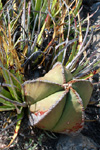 |
The
genus Astrophytum is largely
found in the tropical parts of the Chihuahuan Desert complex of
drylands. This species A. myriostigma,
varies greatly in color. This individual comes from a population of
mostly green individuals. |
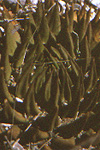
|
It's easy to mistake this Ariocarpus
trigonus in Tamaulipas, Mexico, for a member of
the Agave or Pineapple family. Most of the plant body of this plant is
hiding underground. |
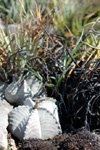
|
In
contrast, this population of A.
myriostigma is made up mostly of brilliant white individuals.
|
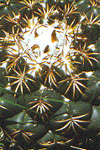
|
A large Coryphantha
elephantidens in tropical dry forest of Guerrero, Mexico. |

|
Astrophytum ornatum is the barrel
cactus of the genus. This species is often more than a meter tall. It
is a lovely plant, with golden spines and white splotches on the dark
green stem. These individuals were photographed growing in a tropical
dry forest with many other cacti, such as the columnar species visible
in the background Stenocereus
dumortieri and S.
queretaroensis, in the state of Guanajuato.
|
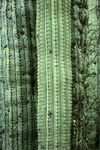
|
The columnar Neobuxbaumia
tetetzo of Puebla and Oaxaca, Mexico, can form extremely dense
stands
that are hard to squeeze through. |
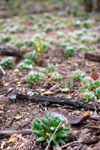 |
The
forest floor is a harsh place for a small, globular cactus. However, Mammillaria sphaerica
manages to grow in dense colonies in the understory of tropical dry
forest on the Gulf Coast of Mexico. These cacti have remarkable
mechanisms for coping with the rapid accumulation of leaf litter in
these forests, which would bury most small cacti. Note the exposed
roots of the individual in the foreground. |
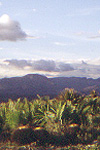
|
Echinocactus platyacanthus
growing with small palms (Brahea) in northern Oaxaca, Mexico. |
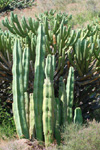
|
A
typical Mexican highland pair: Stenocereus
dumortieri (foreground) and Myrtillocactus
geometrizans (behind) are common large cacti of the central
Mexican dry tropical highlands.
|
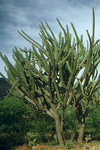
|
The wild architecture of Escontria
chiotilla in Puebla, Mexico. |

|
A
September rainbow over the massive columns of Pachycereus weberi in Puebla state.
|

|
Another unbranched columnar
cactus, Neobuxbaumia mezcalensis, in Guerrero, Mexico. |
|
|
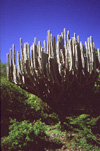
|
The
massive candelabras
of Pachycereus weberi are one of the most memorable images of
Mexico's dry forests. Echinocactus |
|
|
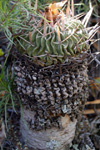
|
Wavy-ribbed
Stenocactus are often
hidden in clumps of grass. This individual in San Luis Potosí is
remarkably tall.
|
|
|
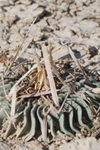
|
Some
cacti grow in the extremely fine soil of muddy desert flats. These
flats are remarkable because the very top of the soil is consolidated
by lichens, bacteria, bryophytes and other tiny organisms into what is
known as a cryptogamic crust. This Stenocactus
pokes through the cryptogamic crust of such a flat in
Tamaulipas.
|
|
|
|
|
|
|















